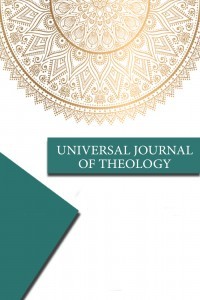Ebû Hayyân el-Endelüsî'nin Tuhfetu'l-Erîb Adlı Eserinde Dilsel Etki
Arap Dili ve Belagatı, Ebû Hayyân el-Endelüsî, Garîbü’l-Ku’ran, Dilsel Etki, Tuhfetü’l-erîb.
The linguistic effect in Tuhfat Al-Arib by Abu Hayyan Al-Andalusi
Arabic Language and Rhetoric, Abu Hayyan al-Andalusi, Strangeness of the Qur’an, Linguistic Effect, Tuhfat al arıb,
___
- الأزهري، أبو منصور محمد بن أحمد. تهذيب اللغة. تحق. محمد عوض مرعب. ط 1 بيروت: دار احياء التراث العربي، 2001.
- البيضاوي، ناصر الدين أبو سعيد عبد الله بن عمر بن محمد الشيرازي. أنوار التنزيل وأسرار التأويل. تحق. محمد عبد الرحمن المرعشلي. ط1 بيروت: دار احياء التراث العربي، 1418.
- البيهقي، أحمد بن الحسين بن علي بن موسى أبو بكر. شعب الإيمان. ط 1 الرياض: مكتبة الرشد للنشر والتوزيع بالتعاون مع الدار السلفية ببومباي بالهند، 1423-2003.
- الجرجاني، علي بن محمد بن علي السيد الشريف. التعريفات. تحقيق ضبطه وصححه جماعة من العلماء بإشراف الناشر. بيروت: دار الكتب العلمية،1 الطبعة، 1983.
- الجوهري، أبو نصر إسماعيل بن حماد. الصحاح تاج اللغة وصحاح العربية. تحق. أحمد عبد الغفور عطار. ط 4 بيروت: دار العلم للملايين، 1407/1987.
- الحاجي خليفة، مصطفى بن عبد الله. كشف الظنون عن أسامي الكتب والفنون. بيروت: دار احياء التراث العربي، 1999.
- ابن حَجر العسقلاني، أبو الفضل أحمد بن علي بن محمد بن أحمد. الدرر الكامنة في أعيان المائة الثامنة. تحق. محمد عبد المعيد ضان. ط2 حيدر أباد: مجلس دائرة المعارف العثمانية، 1392/1972.
- أبو حيان الأندلسي، محمد بن يوسف بن علي بن يوسف. تحفة الأريب بما في القرآن من غريب. تحق. سمير مجذوب. ط1 بيروت: المكتب السامي، 1403/1983.
- الداوودي، محمد بن علي بن أحمد شمس الدين. طبقات المفسرين. بيروت: دار الكتب العلمية.
- ابن دريد الأزدي، أبو بكر محمد بن الحسن. جمهرة اللغة. تحق. رمزي منير بعلبكي. ط1 بيروت: دار العلم للملايين، 1978.
- الرازي، أحمد بن فارس بن زكريا القزويني. معجم مقاييس اللغة. تحق. عبد السلام محمد هارون. دمشق: دار الفكر 1399/1979.
- السبكي، تاج الدين عبد الوهاب بن تقي الدين. معجم الشيوخ. تحق. بشار عواد - رائد يوسف العنبكي - مصطفى إسماعيل الأعظمي. ط1 دار الغرب الإسلامي، 2004.
- السيوطي، جلال الدين عبد الرحمن بن أبي بكر. بغية الوعاة في طبقات اللغويين والنحاة. تحق. محمد أبو الفضل إبراهيم. صيدا: المكتبة العصرية.
- السيوطي، جلال الدين عبد الرحمن بن أبي بكر. الإتقان في علوم القرآن. تحق. محمد أبو الفضل إبراهيم. الهيئة المصرية العامة للكتاب، 1394/1974.
- Başlangıç: 2016
- Yayıncı: İsmail ŞİMŞEK
"Kur'ân Dili ile Bilim Dilinin Kesişme Noktasında "Yedi Gökyüzüne Dair Âyetlerin Yorumu"•
YENİ DİNİ HAREKETLER VE KURTULUŞ ÖĞRETİSİ
İsmet EŞMELİ, Sena Sultan TOPAL
Osman Güman, Nahiv ve Fıkıh Usulü İlişkisi – el-İsnevî Örneği
Dr. Mustafa Kisbet, İslam Hukukunda Tüketicinin Korunması
Kur'an-ı Kerim'in Belâgatında Kısalık
Enes ELVİYO, Bashar AL QAHWAJI
Ebû Hayyân el-Endelüsî'nin Tuhfetu'l-Erîb Adlı Eserinde Dilsel Etki
Müşriklerin Ulu’l-Azm Peygamberlerden Talepleri
İMÂMİYYE ŞÎASININ ÖNDE GELEN TEMSİLCİLERİNDEN ŞEYH MÜFÎD’İN TEFSİR YÖNÜ ÜZERİNE
